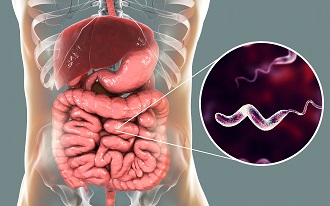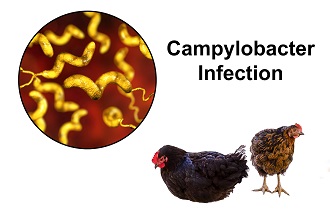
Genetic and non-genetic factors in Campylobacter levels in poultry
Researchers explored variation at specific positions in chickens’ genome and their association with Campylobacter in the birds’ guts. The study concluded that, although there are genetic factors that influence Campylobacter colonisation, these factors play a relatively minor role.

Challenge
Campylobacter is the leading bacterial cause of food-borne gastroenteritis worldwide. Symptoms of infection include diarrhoea, fever, vomiting and stomach cramps. Campylobacteriosis exerts profound societal and economic costs to the UK and other countries. The World Health Organization has estimated that Campylobacter causes 95 million illnesses, 21,000 deaths and loss of 2.1 million disability-adjusted life years globally. In the UK alone, there were 63,946 laboratory-confirmed human cases in 2017.
The ratio of unreported cases of human campylobacteriosis to those captured by national surveillance systems in the UK is estimated to be 9.3 to 12, therefore the true burden may exceed half a million cases per annum at a projected median cost to the national health service of £50 million.
Poultry is the main reservoir of human campylobacteriosis and up to 80% of human cases may be attributable to this avian reservoir. During 2016–2017, a UK-wide survey indicated that 54% of fresh retail chicken was contaminated with viable Campylobacter.
The reduction in the number of Campylobacter on broiler (chickens bred for meat) carcasses could reduce the incidence of human disease due to contaminated chicken by up to 30-fold. A pressing need therefore exists for strategies to reduce the entry of Campylobacter-contaminated poultry meat into the food chain.

Solution
An RVC-led study, in collaboration with the poultry breeding company Aviagen, investigated the genetic make-up of 3,000 chickens bred for meat. The aim of the study was to identify if elements of the chickens’ genetic code were linked to resistance to colonisation by Campylobacter bacteria.
The researchers explored variation at specific positions in the chickens’ genome and their association with numbers of Campylobacter bacteria in the gut of the birds. The study also analysed the expression of genes in chickens that were resistant or susceptible to colonisation by the bacteria.
The study concluded that, although there are genetic factors that influence Campylobacter colonisation, these factors play a minor role, meaning it is crucial to characterise and understand the role of the non-genetic and environmental factors to further reduce Campylobacter levels in poultry.
All the chickens were naturally exposed to Campylobacter present in their environment, which reflects how chickens are exposed in commercial farm settings.
Impact
As environmental factors were found to play a more significant role than genetic factors in Campylobacter colonisation, a multifactorial approach addressing both genetic and non-genetic factors is needed to reduce Campylobacter levels in poultry and the incidence of the human disease attributed to this source.
The published research article of this study in Nature states that quantitative risk assessments predict that even a relatively modest reduction in the number of Campylobacter on broiler carcasses could reduce the incidence of human disease due to contaminated chicken by up to 30-fold and a pressing need therefore exists for strategies to reduce the entry of Campylobacter-contaminated poultry meat into the food chain.
Partners
Publications
| Title | Publication | Year |
| Quantitative trait loci and transcriptome signatures associated with avian heritable resistance to Campylobacter | Nature | 2021 |
